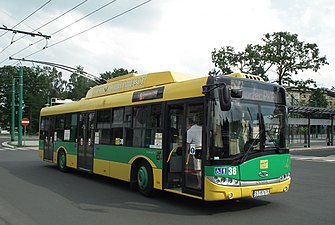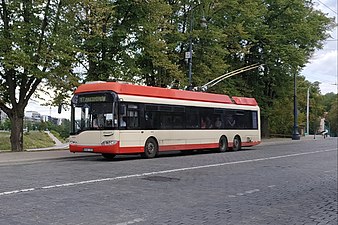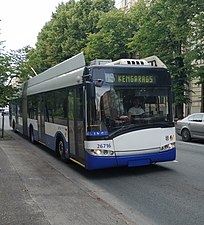Solaris Trollino
You can help expand this article with text translated from the corresponding article in Polish. (November 2021) Click [show] for important translation instructions.
- Machine translation, like DeepL or Google Translate, is a useful starting point for translations, but translators must revise errors as necessary and confirm that the translation is accurate, rather than simply copy-pasting machine-translated text into the English Wikipedia.
- Consider adding a topic to this template: there are already 1,471 articles in the main category, and specifying
|topic=will aid in categorization. - Do not translate text that appears unreliable or low-quality. If possible, verify the text with references provided in the foreign-language article.
- You must provide copyright attribution in the edit summary accompanying your translation by providing an interlanguage link to the source of your translation. A model attribution edit summary is
Content in this edit is translated from the existing Polish Wikipedia article at [[:pl:Solaris Trollino]]; see its history for attribution. - You may also add the template
{{Translated|pl|Solaris Trollino}}to the talk page. - For more guidance, see Wikipedia:Translation.
Motor vehicle
| Solaris Trollino | |
|---|---|
 Solaris Trollino 12 4th generation in Vilnius | |
| Overview | |
| Manufacturer | Solaris Bus & Coach |
| Also called | Škoda 26Tr, Škoda 27Tr, Škoda 28Tr, Škoda-Solaris 24M |
| Production | 2002-present |
| Assembly | Bolechowo-Osiedle, Poland |
| Body and chassis | |
| Class | Single-deck trolleybus |
| Doors | 2-5 doors |
| Floor type | Low floor |
| Powertrain | |
| Power output | 160–320 kW (214.6–429.1 hp) |
| Dimensions | |
| Length | 12,000–18,750 mm (472.4–738.2 in) |
| Width | 2,550 mm (100.4 in) |
| Height | 3,450 mm (135.8 in) |
| Curb weight | 11,400–18,500 kg (25,132.7–40,785.5 lb) |
Solaris Trollino is a series of low-floor trolleybuses designed for public transport, produced since 1999 by the Polish company Solaris Bus & Coach.[1] The power regulation electronics and traction motors are delivered by other companies, such as Škoda Electric, Kiepe Electric, Medcom [pl] or Cegelec.[1]
The first prototype was produced in 2001 and ran the first races on the Gdynia road network.[2]
Description and models
There are four different length variants (the number indicates length in meters):
- Solaris Trollino 12 (also sold as Škoda 26Tr Solaris)
- Solaris Trollino 15 (also sold as Škoda 28Tr Solaris) - no longer in production
- Solaris Trollino 18 (articulated, also sold as Škoda 27Tr Solaris)
- Solaris Trollino 24 (bi-articulated, also sold as Škoda-Solaris 24M)
| Type | Number manufactured | Powertrain options |
|---|---|---|
| Solaris Trollino 12 / Škoda 26Tr Solaris | 182 / 302[3] | Škoda 160 kW, Kiepe 160 kW, MEDCOM 175 kW[1] |
| Solaris Trollino 15 / Škoda 28Tr Solaris | 49 / 35[3] | Škoda 250 kW[3] |
| Solaris Trollino 18 / Škoda 27Tr Solaris | 114 / 260[3] | Škoda 250 kW, Kiepe 2x160 kW, MEDCOM 250 kW[1] |
| Solaris Trollino 24 / Škoda-Solaris 24M | 1 / 36 | Kiepe 2x160 kW[1] |
The trolleybuses can be fully dependent on wires, or they can be equipped with supercapacitors, batteries, fuel cells or diesel generators.
-
 Solaris Trollino 12 3rd generation in Tychy
Solaris Trollino 12 3rd generation in Tychy -
 Solaris Trollino 15 1st generation in Vilnius
Solaris Trollino 15 1st generation in Vilnius -
 Solaris Trollino 18 3rd generation in Riga
Solaris Trollino 18 3rd generation in Riga -
 Solaris Trollino 24 prototype
Solaris Trollino 24 prototype
References

Wikimedia Commons has media related to Solaris Trollino.
- ^ a b c d e "Trollino". www.solarisbus.com (in English and Polish). Retrieved 2017-12-16.
- ^ "History". www.solarisbus.com (in English and Polish). Retrieved 2017-12-16.
- ^ a b c d Šplíchal, Jiří (2021). 85 let výroby trolejbusů Škoda (in Czech). Plzeň: SPVD. p. 326. ISBN 978-80-270-9960-3.














